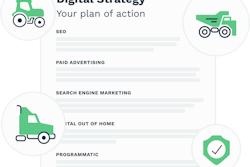
What you need to know:
- In response to federal rollbacks and lawsuits targeting California’s zero-emission vehicle (ZEV) policies, the state released a new report outlining plans to expand ZEV adoption across all vehicle types.
- The report responds to a June 12 executive order from Gov. Newsom directing state agencies to promote affordability, access, and reliability in clean transportation.
- Strategies include increasing private investment, replacing expiring federal tax credits with state-level support for low-income consumers and small businesses, expanding EV and hydrogen infrastructure with streamlined permitting and lower charging costs, new consumer protections, and requiring state agencies to purchase ZEVs.
- California’s HVIP funding program will reopen on September 9, offering point-of-sale incentives to make zero-emission commercial vehicles more affordable for fleets.
In response to recent federal rollbacks and lawsuits targeting California's zero-emission vehicle (ZEV) policies, the Golden State is pushing back with a new report detailing plans to expand ZEV adoption across all vehicle types.
The report, filed in response to Gov. Gavin Newsom's June 12 Executive Order directing multiple state agencies, including the California Air Resources Board (CARB) and the California Energy Commission (CEC), recommends a list of strategies pushing for greater affordability and access to reliable clean transport.
[Related: CARB policies don't reflect reality, says Port of Oakland operator]
The report's key recommendations focus primarily on increasing private investment, replacing expiring federal tax credits with state-level funding for low-income consumers and small businesses, boosting EV charging and hydrogen fueling infrastructure with a streamlined permitting process, reduce charging costs, new consumer protection rules, and a request for state agencies to purchase ZEVs for their fleets.
[Related: CARB to allow ZEV credit transfers across states, classes]
Additional incentives
Private investment remains a key priority, especially through the already established Low Carbon Fuel Standard (LCFS) that's already generated around $4 billion annually as a result of over 200 clean fuel-producing and infrastructure companies and utilities generating credits to help subsidize clean fuels. To date, over $300 million in LFCS credits has gone to state transit agencies.
Providing additional incentives, however, is "contingent upon available resources," so nothing is guaranteed at this time. But federal clean vehicle tax credits are slated to cease on September 30. The Newsom administration, therefore, needs to act soon on this matter.
Charging reliability
Reliable charging and hydrogen infrastructure remains a sticking point. Clean Trucking reported earlier this year about a lack of hydrogen refueling for Class 8 rigs, specifically the discontinued Nikola Tre FCEV. So far, CARB nor any other state agency has helped owner-operators get access to affordable fuel.
[Related: Nikola's collapse brings headaches, financial problems for fleets]
The reports cites "pending regulations" that exist to increase EV charging reliability by quickly resolving technical issues and to provide flexible payment methods at public chargers.
New regulations
The report outlines two key regulatory recommendations aimed at protecting consumers and ensuring all communities benefit from cleaner air.
First, it proposes advancing zero-emission vehicle (ZEV) consumer assurance measures. The Department of Consumer Affairs (DCA) or the California State Transportation Agency (CalSTA) should explore and potentially implement protections to boost buyer confidence in ZEVs. These could include requirements for battery warranties, vehicle durability standards, and transparent battery health data. The goal is to ensure ZEVs are as reliable and repairable as conventional gas-powered vehicles.
The second recommendation calls for a statewide indirect source rule, developed by CARB in coordination with local air districts. This rule would target emissions from mobile sources that frequently operate at large facilities such as warehouses, ports, airports, and railyards. By regulating these high-traffic areas, the state aims to reduce pollution in nearby communities, many of which are disproportionately impacted by poor air quality.
ZEVs for local governments
The report calls for a "ZEV-first" approach in state procurement, urging California to prioritize the use of ZEVs in all state-contracted services, including delivery and rental contracts. It recommends that the state procure ZEVs and install supporting infrastructure wherever feasible, and that state facilities prioritize the deployment of EV charging stations. Additionally, CARB is encouraged to explore voluntary fleet recognition programs, allowing companies that operate ZEVs to gain preference in state procurement processes.
To support local government fleet electrification, the report proposes updates to state funding guidelines to either require or strongly incentivize ZEV purchases by local governments and transit agencies. It also recommends developing statewide cooperative purchasing strategies to help local agencies access ZEVs at the lowest possible cost to make the transition to cleaner fleets more affordable and efficient.
HVIP program returns
In related and equally important news, California's refreshed HVIP (Hybrid and Zero-Emission Truck and Bus Voucher Incentive Project) funding program is set to reopen on September 9th. This initiative plays a vital role in speeding up the adoption of next-generation zero-emission commercial vehicles by reducing their upfront costs for fleets.
This latest funding wave offers important point-of-sale incentives, making clean trucks and buses more affordable for fleets of all sizes, which will soon be eligible for vouchers ranging from $120,000 to $330,000.












